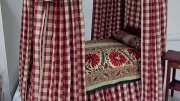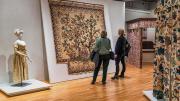A good night’s sleep was likely hard to come by in early American homes. Privacy was rare—any beds were located in common spaces—and only householders with seniority got one; children, servants, and guests were treated to pallets, or bare floors. Rope-strung supports tightened with a wooden peg (from which the phrase “sleep tight” derives) held mattresses stuffed with horsehair, straw, wool, and moss—or, at best, with goose feathers. Curtains mitigated cold winter drafts and helped shelter sleepers (or those engaged in other, personal nighttime activities). Beds and linens were labor-intensive to produce, or extremely expensive to buy. As “Bed Furnishings in Early America: An Intimate Look”—at the Wadsworth Atheneum Museum of Art, in Hartford, Connecticut, further reveals: “Before the mid-twentieth century, a clean, comfortable bed was a luxury.”
Open through January 27, the show highlights textiles and furniture from the seventeenth to the early nineteenth centuries. An “English bed furnishing set” from 1650-1700, which was transported to America, features an enclosure made of fustian valances and curtains embroidered with crewel yarn in a flamboyant vine-and-flower pattern. A miniature, scaled version of a New England high-post bed (ca. 1750-1765) features historically accurate red-gingham bed furnishings (above) made by Natalie Larson, an expert on historic textiles and reproductions based in Williamsburg, Virginia. Other exceptional handwork, which took artisans and homemakers countless hours to complete, is also on display in bed hangings and rugs, coverlets, and quilts.
All told, the exhibit concludes that despite the bed’s central role in reproduction, birthing, sickness, and death, holding apart “a space for comfort, warmth, and security” was largely a status symbol reflecting a homeowner’s financial standing and specific physical and emotional needs.










